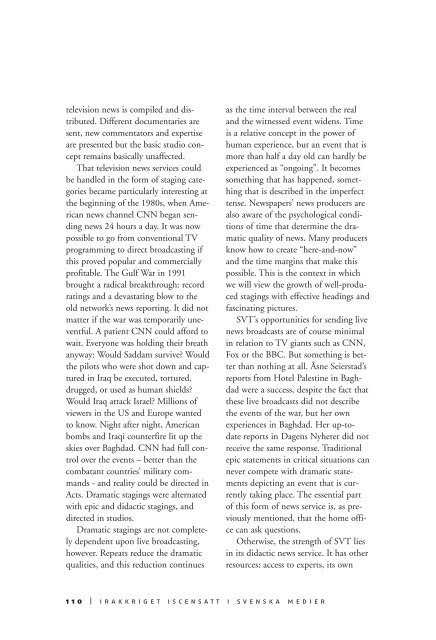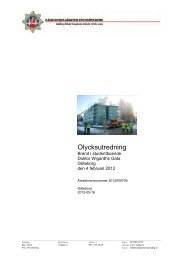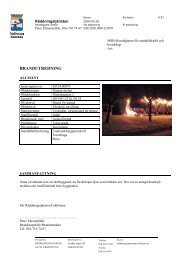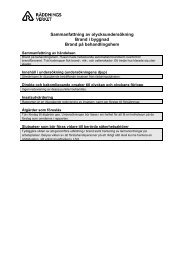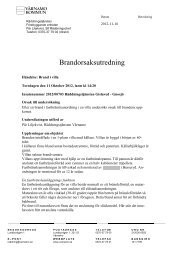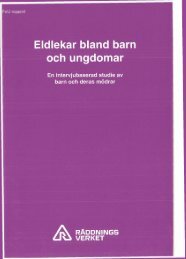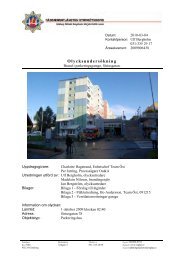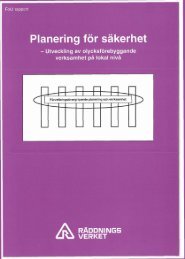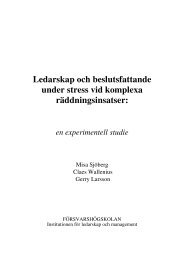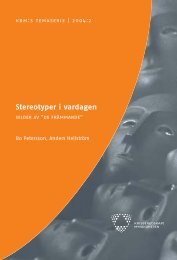Bagdad-Bob, menige Jessica Lynch och Cirkus Saddam
Bagdad-Bob, menige Jessica Lynch och Cirkus Saddam
Bagdad-Bob, menige Jessica Lynch och Cirkus Saddam
You also want an ePaper? Increase the reach of your titles
YUMPU automatically turns print PDFs into web optimized ePapers that Google loves.
television news is compiled and distributed.<br />
Different documentaries are<br />
sent, new commentators and expertise<br />
are presented but the basic studio concept<br />
remains basically unaffected.<br />
That television news services could<br />
be handled in the form of staging categories<br />
became particularly interesting at<br />
the beginning of the 1980s, when American<br />
news channel CNN began sending<br />
news 24 hours a day. It was now<br />
possible to go from conventional TV<br />
programming to direct broadcasting if<br />
this proved popular and commercially<br />
profitable. The Gulf War in 1991<br />
brought a radical breakthrough: record<br />
ratings and a devastating blow to the<br />
old network’s news reporting. It did not<br />
matter if the war was temporarily uneventful.<br />
A patient CNN could afford to<br />
wait. Everyone was holding their breath<br />
anyway: Would <strong>Saddam</strong> survive Would<br />
the pilots who were shot down and captured<br />
in Iraq be executed, tortured,<br />
drugged, or used as human shields<br />
Would Iraq attack Israel Millions of<br />
viewers in the US and Europe wanted<br />
to know. Night after night, American<br />
bombs and Iraqi counterfire lit up the<br />
skies over Baghdad. CNN had full control<br />
over the events – better than the<br />
combatant countries’ military commands<br />
- and reality could be directed in<br />
Acts. Dramatic stagings were alternated<br />
with epic and didactic stagings, and<br />
directed in studios.<br />
Dramatic stagings are not completely<br />
dependent upon live broadcasting,<br />
however. Repeats reduce the dramatic<br />
qualities, and this reduction continues<br />
as the time interval between the real<br />
and the witnessed event widens. Time<br />
is a relative concept in the power of<br />
human experience, but an event that is<br />
more than half a day old can hardly be<br />
experienced as “ongoing”. It becomes<br />
something that has happened, something<br />
that is described in the imperfect<br />
tense. Newspapers’ news producers are<br />
also aware of the psychological conditions<br />
of time that determine the dramatic<br />
quality of news. Many producers<br />
know how to create “here-and-now”<br />
and the time margins that make this<br />
possible. This is the context in which<br />
we will view the growth of well-produced<br />
stagings with effective headings and<br />
fascinating pictures.<br />
SVT’s opportunities for sending live<br />
news broadcasts are of course minimal<br />
in relation to TV giants such as CNN,<br />
Fox or the BBC. But something is better<br />
than nothing at all. Åsne Seierstad’s<br />
reports from Hotel Palestine in Baghdad<br />
were a success, despite the fact that<br />
these live broadcasts did not describe<br />
the events of the war, but her own<br />
experiences in Baghdad. Her up-todate<br />
reports in Dagens Nyheter did not<br />
receive the same response. Traditional<br />
epic statements in critical situations can<br />
never compete with dramatic statements<br />
depicting an event that is currently<br />
taking place. The essential part<br />
of this form of news service is, as previously<br />
mentioned, that the home office<br />
can ask questions.<br />
Otherwise, the strength of SVT lies<br />
in its didactic news service. It has other<br />
resources: access to experts, its own<br />
110 | irakkriget iscensatt i svenska medier


